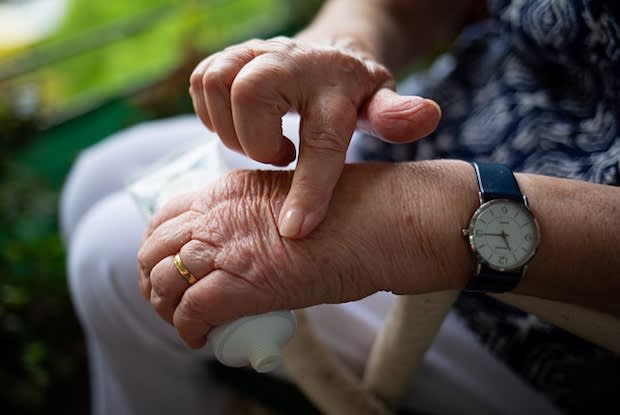Table of Contents
Arthritis Overview
Living with arthritis can make it difficult to perform everyday activities. There are several different types of arthritis that can affect people, but each one can hinder a person’s ability to participate in exercise. This is a huge issue for many because a sedentary lifestyle increases your chances of developing other serious disorders like high blood pressure and high cholesterol.
Older people are more likely to have wear-and-tear arthritis (osteoarthritis), and advanced age can also make it more difficult to exercise. Having arthritis causes swelling and tenderness in one or more joints. Over time, the joints may become stiff and deformed, especially in the case of rheumatoid arthritis. In general, the most common arthritis symptoms are pain, swelling, redness, and a decreased range of motion. These symptoms may make it sound impossible to work out, but there are many options for arthritis patients. [1]
When arthritis patients find a good exercise for them, it can help improve their range of motion and overall body health. Read on to learn more about arthritis-friendly exercises along with medications like generic Celebrex, Voltaren Emulgel, Mobic (meloxicam), or Medrol (methylprednisone). There is no one-size-fits-all exercise for arthritis patients. It is important to work with your doctor to ensure that the exercise you choose is safe for you. It is essential not to jump into every new exercise trend because everyone has their own ability level. Low-impact exercises are typically a safe bet because they do not put as much pressure on the joints. Working out in a pool can be a great option for arthritis patients. Water workouts minimize pain and reduce joint stress. Water has 12 times the resistance of air, so you can still receive a good workout in the water. You can effectively build muscle and improve your range of motion by swimming laps, taking water aerobics, or other water fitness classes. Some pools are designed for arthritis patients and have warmer water, which can further soothe joint pain. [2] Many do not consider walking to be exercise, but it can be incredibly helpful for arthritis patients to get their legs moving. Not every exercise session has to be super strenuous and heart-pumping; walking a few laps around your neighborhood is a great start for many people suffering from joint pain or stiffness. Walking strengthens the bones and muscles and may reduce the severity of symptoms. Doctors recommend at least 150 minutes of brisk walking every week to reduce arthritis symptoms. [2] If aerobic activity is not your thing, you may want to try some slower-paced flexibility exercises like yoga or pilates. Before starting these exercises, you should consult your doctor to ensure your condition allows you to perform them safely. Today, yoga is an incredibly common exercise that many people prefer over other aerobic activities. The barrier to entry for yoga is low, and all you need is a spongy yoga mat and an internet connection. There are millions of yoga instruction videos online, so many arthritic patients can try this exercise for free in their own homes. If you have more advanced arthritis, you may want to take a professional class with a qualified instructor to ensure you are performing movements that protect your joints. [2] Arthritis in the hands is incredibly common, and it may make it difficult to perform repetitive activities like typing on a computer and eating with utensils. Patients should stretch the muscles in the hands just like every other muscle in the body. One beneficial exercise is to spread your fingers as wide as possible then make a fist in a squeezing motion. You can do this ten times with each hand to reduce joint pain. [2] As mentioned above, it is pertinent to tell your doctor about any new exercises you try. Once you receive the green light, you should still exercise as much caution as possible. You may want to start slowly if you have not been active in a while. Do not push yourself too hard and take a break if you notice unusual aches or pains in your arthritic joints. Exercising can help with symptoms, but you should maintain your medication routine and take Voltaren Emulgel, Mobic (meloxicam), Celebrex (celecoxib), or Medrol (methylprednisolone) as prescribed. Before and after an exercise session, you may want to implement the following into your routine: Apply heat before you start: If you apply heat to your affected joints before you begin, it can relieve any lingering pain. You can use warm towels, hot packs, or a shower to warm up your joints. Twenty minutes is a good length of time for arthritic heat treatment. Move gently: It is important to start your exercise slowly. You may want to warm up for ten minutes with some range-of-motion exercises before starting more intensive aerobic exercises. Stretching also reduces the risk of muscle and joint injury. Ice after a workout: Once you complete your exercise session, you can apply ice packs to your arthritic joints for 20 minutes to reduce swelling and joint pain. [3] The content provided in this article is based on thorough research and in some cases, reviewed by a medical professional. Our goal for the information is to provide helpful, general health informational. It is not intended as a substitute for professional medical advice.
Low Impact Exercises
a. Water Workouts
b. Walking

Flexibility Exercises
a. Yoga
b. Hand Stretching
Arthritis Exercise Tips

